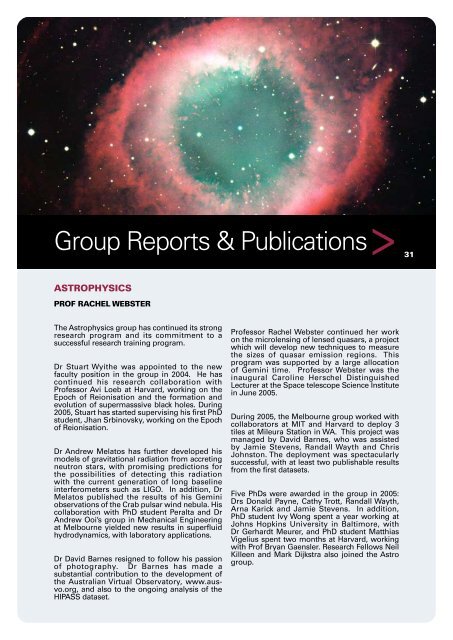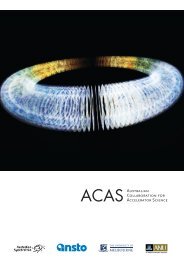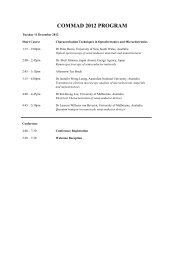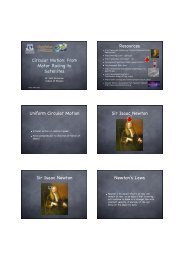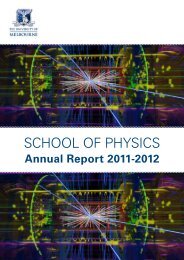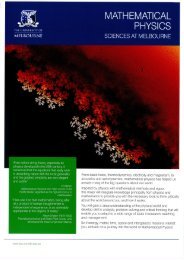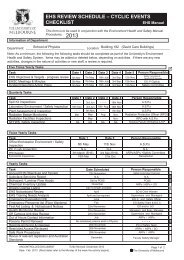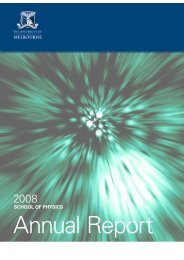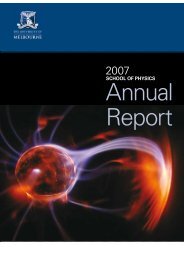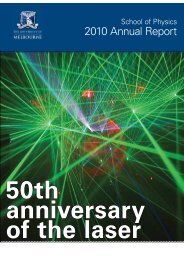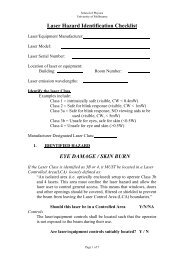Annual Report 2005.pdf - School of Physics - University of Melbourne
Annual Report 2005.pdf - School of Physics - University of Melbourne
Annual Report 2005.pdf - School of Physics - University of Melbourne
Create successful ePaper yourself
Turn your PDF publications into a flip-book with our unique Google optimized e-Paper software.
Group <strong>Report</strong>s & Publications><br />
31<br />
ASTROPHYSICS<br />
PROF RACHEL WEBSTER<br />
The Astrophysics group has continued its strong<br />
research program and its commitment to a<br />
successful research training program.<br />
Dr Stuart Wyithe was appointed to the new<br />
faculty position in the group in 2004. He has<br />
continued his research collaboration with<br />
Pr<strong>of</strong>essor Avi Loeb at Harvard, working on the<br />
Epoch <strong>of</strong> Reionisation and the formation and<br />
evolution <strong>of</strong> supermasssive black holes. During<br />
2005, Stuart has started supervising his first PhD<br />
student, Jhan Srbinovsky, working on the Epoch<br />
<strong>of</strong> Reionisation.<br />
Dr Andrew Melatos has further developed his<br />
models <strong>of</strong> gravitational radiation from accreting<br />
neutron stars, with promising predictions for<br />
the possibilities <strong>of</strong> detecting this radiation<br />
with the current generation <strong>of</strong> long baseline<br />
interferometers such as LIGO. In addition, Dr<br />
Melatos published the results <strong>of</strong> his Gemini<br />
observations <strong>of</strong> the Crab pulsar wind nebula. His<br />
collaboration with PhD student Peralta and Dr<br />
Andrew Ooi’s group in Mechanical Engineering<br />
at <strong>Melbourne</strong> yielded new results in superfluid<br />
hydrodynamics, with laboratory applications.<br />
Dr David Barnes resigned to follow his passion<br />
<strong>of</strong> photography. Dr Barnes has made a<br />
substantial contribution to the development <strong>of</strong><br />
the Australian Virtual Observatory, www.ausvo.org,<br />
and also to the ongoing analysis <strong>of</strong> the<br />
HIPASS dataset.<br />
Pr<strong>of</strong>essor Rachel Webster continued her work<br />
on the microlensing <strong>of</strong> lensed quasars, a project<br />
which will develop new techniques to measure<br />
the sizes <strong>of</strong> quasar emission regions. This<br />
program was supported by a large allocation<br />
<strong>of</strong> Gemini time. Pr<strong>of</strong>essor Webster was the<br />
inaugural Caroline Herschel Distinguished<br />
Lecturer at the Space telescope Science Institute<br />
in June 2005.<br />
During 2005, the <strong>Melbourne</strong> group worked with<br />
collaborators at MIT and Harvard to deploy 3<br />
tiles at Mileura Station in WA. This project was<br />
managed by David Barnes, who was assisted<br />
by Jamie Stevens, Randall Wayth and Chris<br />
Johnston. The deployment was spectacularly<br />
successful, with at least two publishable results<br />
from the first datasets.<br />
Five PhDs were awarded in the group in 2005:<br />
Drs Donald Payne, Cathy Trott, Randall Wayth,<br />
Arna Karick and Jamie Stevens. In addition,<br />
PhD student Ivy Wong spent a year working at<br />
Johns Hopkins <strong>University</strong> in Baltimore, with<br />
Dr Gerhardt Meurer, and PhD student Matthias<br />
Vigelius spent two months at Harvard, working<br />
with Pr<strong>of</strong> Bryan Gaensler. Research Fellows Neil<br />
Killeen and Mark Dijkstra also joined the Astro<br />
group.


